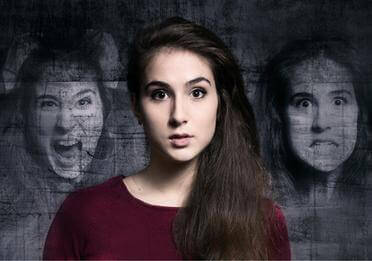Brief Psychotic Disorder: Symptoms and Treatment

When do we say that a person is “crazy”? How do we define “madness”? Many definitions have been given and there are many varying perspectives on the phenomenon of madness. We’ll demonstrate this here by talking about brief psychotic disorder.
Traditionally, we have made a distinction between two major groups of disorders in psychiatry: psychotic disorders and neurotic disorders. In general, we can define madness as a psychotic state.
Psychoses or psychotic states entail a loss of contact with reality manifested by means of delusions and/or hallucinations. On the other hand, neuroses or neurotic states do not entail a loss of contact with reality. Examples of neurotic disorders would be depression and anxiety. Classic examples of psychosis would be schizophrenia and bipolar disorder.
Key characteristics that define psychotic disorders: delusions and hallucinations
When we speak about a psychotic disorder such as brief psychotic disorder, we refer to its manifestations or symptoms. In brief psychotic disorder there are two types of disturbances in the perception of reality: delusions and hallucinations.

When we talk about delusions, we are referring to fixed beliefs that do not correspond to reality and do not respond to evidence against them. Etymologically the word delirium derives from the Latin term delirare, which literally means to deviate from the furrow. If we apply it to thought, it would mean something like “thinking outside of the normal groove”.
In layman’s terms, to be delirious means “to rave, to be deranged”. In everyday language, delirium is practically synonymous with madness, raving, loss of touch with reality, and the opposite of reason.
Characteristics of delusions
To identify a delirium as such, we should take into account the degree to which the experience has the following characteristics:
- They are held to with absolute conviction.
- They are experienced as a self-evident truth with great personal significance.
- Their content is often fantastical or at least intrinsically improbable.
- They do not allow themselves to be modified by reason or experience.
- The beliefs are not shared by other members of the social or cultural group.
- The person is preoccupied with the belief and finds it difficult to avoid thinking or talking about it.
- They are a source of subjective distress or interfere with the social functioning of the person and their job.
In short, delusions are characterized as being conceptually very complex. Perhaps that is why it’s so difficult to “box” them into a definition. A classic example of a delusion would be that of a person who is convinced that someone is spying on him or controlling him through hidden cameras. Think of a person who thinks they are Napoleon. Another example is a person who thinks he has the divine mission to save the world from its destruction.
What do we mean by hallucination?
Hallucinations are perceptions that occur without the presence of an external stimulus. They are vivid and clear, with all the power and impact of normal perceptions. In addition, they are not subject to voluntary control.
Hallucinations can occur in any sensory modality. However, auditory hallucinations are the most common in brief psychotic disorder and schizophrenia. These hallucinations are usually in the form of voices that a person perceives as different from their own thoughts.
Classic examples of hallucinations include people who hear voices that tell them that they must carry out a particular mission. Another example is a person sees insects crawling over their arms.

Brief psychotic disorder
The essential characteristic of brief psychotic disorder is a disturbance involving the abrupt onset of at least one of the following psychotic symptoms:
- delusions
- hallucinations
- disorganized language or speech
- highly anomalous psycho-motor behaviour, including catatonia. Catatonia is defined as a neuropsychiatric syndrome characterized by motor abnormalities, which occur in association with disturbances in awareness, affect and thinking.
Seizures may develop, but they are more common when the cause is organic. Ultimately (in both organic and psychiatric cases), it is thought that catatonia has its origin in a dysfunction of the lateral orbitofrontal cortex.
The abrupt onset of brief psychotic disorder is defined as a change from a non-psychotic state to a clearly psychotic one within a period of 2 weeks. An episode of the disorder lasts for at least 1 day but less than 1 month. Finally, the individual returns fully to their prior level of functioning.
Characteristics of brief psychotic disorder
According to the DSM-5, for a diagnosis of brief psychotic disorder, the following criteria must be met:
A. Presence of one (or more) of the following symptoms. At least one of them must be (1), (2) or (3):
- Delusions
- Hallucinations
- Disorganized speech (disorganized language)
- Very disorganized or catatonic behavior
B. The duration of an episode of the disorder is at least one day but less than one month. Also, the person eventually must return fully to their prior level of functioning.
C. The disorder is not better explained by bipolar or major depressive disorder, bipolar with psychotic characteristics, or another psychotic disorder such as schizophrenia or catatonia. It cannot be attributed to the physiological effects of a substance (e.g. a drug or a medication) or another medical condition.

As we can see, a person who goes through a brief psychotic disorder quickly passes from a state of “normality” to a psychotic state, almost without warning. This state of “madness” lasts between one day and one month (never more than that). Eventually, the person recovers completely or returns to their baseline.
The differences with schizophrenia are clear. In schizophrenia, the signs last for a minimum of six months. Additionally, the change from “normality” to “madness” is usually not so quick, but rather more gradual. Schizophrenia is usually chronic, while brief psychotic disorder usually resolves itself or is “cured”.
Even if the disorder is brief, it can become acute
People with brief psychotic disorder usually experience emotional agitation or significant confusion. They may present with rapid changes from one intense affect to another. Although the disorder is brief, the degree of dysfunction can be acute when symptoms are present.
They may require supervision, in terms of nutrition, hygiene, and safety from the consequences of their own lack of judgment, cognitive dysfunction and delusions. Moreover, during brief psychotic disorder there appears to be a higher risk of suicidal behavior. This is especially so during an acute episode. In this case, safety measures are crucial.
Treatment of brief psychotic disorder
Medication is the main intervention for psychoses, but treatment in the initial phase should not be exclusively medication. Both psycho-social interventions and psychological therapy are very important in the recovery process.

The aim should be to:
- minimize the vulnerability of the patient in stressful situations
- facilitate the recovery processes
- strengthen their resilience
- improve family, social and educational-work functioning
- give them resources to deal with interpersonal or personal conflicts, problems and tensions
To conclude, brief psychotic disorder can have significant consequences on the person as well as their relationships. It is therefore essential for a qualified professional to intervene.
Bibliographic references
American Psychiatry Association (2014). Diagnostic and Statistical Manual of Mental Disorders, (DSM-5), 5th Ed. Madrid: Editorial Médica Panamericana.
When do we say that a person is “crazy”? How do we define “madness”? Many definitions have been given and there are many varying perspectives on the phenomenon of madness. We’ll demonstrate this here by talking about brief psychotic disorder.
Traditionally, we have made a distinction between two major groups of disorders in psychiatry: psychotic disorders and neurotic disorders. In general, we can define madness as a psychotic state.
Psychoses or psychotic states entail a loss of contact with reality manifested by means of delusions and/or hallucinations. On the other hand, neuroses or neurotic states do not entail a loss of contact with reality. Examples of neurotic disorders would be depression and anxiety. Classic examples of psychosis would be schizophrenia and bipolar disorder.
Key characteristics that define psychotic disorders: delusions and hallucinations
When we speak about a psychotic disorder such as brief psychotic disorder, we refer to its manifestations or symptoms. In brief psychotic disorder there are two types of disturbances in the perception of reality: delusions and hallucinations.

When we talk about delusions, we are referring to fixed beliefs that do not correspond to reality and do not respond to evidence against them. Etymologically the word delirium derives from the Latin term delirare, which literally means to deviate from the furrow. If we apply it to thought, it would mean something like “thinking outside of the normal groove”.
In layman’s terms, to be delirious means “to rave, to be deranged”. In everyday language, delirium is practically synonymous with madness, raving, loss of touch with reality, and the opposite of reason.
Characteristics of delusions
To identify a delirium as such, we should take into account the degree to which the experience has the following characteristics:
- They are held to with absolute conviction.
- They are experienced as a self-evident truth with great personal significance.
- Their content is often fantastical or at least intrinsically improbable.
- They do not allow themselves to be modified by reason or experience.
- The beliefs are not shared by other members of the social or cultural group.
- The person is preoccupied with the belief and finds it difficult to avoid thinking or talking about it.
- They are a source of subjective distress or interfere with the social functioning of the person and their job.
In short, delusions are characterized as being conceptually very complex. Perhaps that is why it’s so difficult to “box” them into a definition. A classic example of a delusion would be that of a person who is convinced that someone is spying on him or controlling him through hidden cameras. Think of a person who thinks they are Napoleon. Another example is a person who thinks he has the divine mission to save the world from its destruction.
What do we mean by hallucination?
Hallucinations are perceptions that occur without the presence of an external stimulus. They are vivid and clear, with all the power and impact of normal perceptions. In addition, they are not subject to voluntary control.
Hallucinations can occur in any sensory modality. However, auditory hallucinations are the most common in brief psychotic disorder and schizophrenia. These hallucinations are usually in the form of voices that a person perceives as different from their own thoughts.
Classic examples of hallucinations include people who hear voices that tell them that they must carry out a particular mission. Another example is a person sees insects crawling over their arms.

Brief psychotic disorder
The essential characteristic of brief psychotic disorder is a disturbance involving the abrupt onset of at least one of the following psychotic symptoms:
- delusions
- hallucinations
- disorganized language or speech
- highly anomalous psycho-motor behaviour, including catatonia. Catatonia is defined as a neuropsychiatric syndrome characterized by motor abnormalities, which occur in association with disturbances in awareness, affect and thinking.
Seizures may develop, but they are more common when the cause is organic. Ultimately (in both organic and psychiatric cases), it is thought that catatonia has its origin in a dysfunction of the lateral orbitofrontal cortex.
The abrupt onset of brief psychotic disorder is defined as a change from a non-psychotic state to a clearly psychotic one within a period of 2 weeks. An episode of the disorder lasts for at least 1 day but less than 1 month. Finally, the individual returns fully to their prior level of functioning.
Characteristics of brief psychotic disorder
According to the DSM-5, for a diagnosis of brief psychotic disorder, the following criteria must be met:
A. Presence of one (or more) of the following symptoms. At least one of them must be (1), (2) or (3):
- Delusions
- Hallucinations
- Disorganized speech (disorganized language)
- Very disorganized or catatonic behavior
B. The duration of an episode of the disorder is at least one day but less than one month. Also, the person eventually must return fully to their prior level of functioning.
C. The disorder is not better explained by bipolar or major depressive disorder, bipolar with psychotic characteristics, or another psychotic disorder such as schizophrenia or catatonia. It cannot be attributed to the physiological effects of a substance (e.g. a drug or a medication) or another medical condition.

As we can see, a person who goes through a brief psychotic disorder quickly passes from a state of “normality” to a psychotic state, almost without warning. This state of “madness” lasts between one day and one month (never more than that). Eventually, the person recovers completely or returns to their baseline.
The differences with schizophrenia are clear. In schizophrenia, the signs last for a minimum of six months. Additionally, the change from “normality” to “madness” is usually not so quick, but rather more gradual. Schizophrenia is usually chronic, while brief psychotic disorder usually resolves itself or is “cured”.
Even if the disorder is brief, it can become acute
People with brief psychotic disorder usually experience emotional agitation or significant confusion. They may present with rapid changes from one intense affect to another. Although the disorder is brief, the degree of dysfunction can be acute when symptoms are present.
They may require supervision, in terms of nutrition, hygiene, and safety from the consequences of their own lack of judgment, cognitive dysfunction and delusions. Moreover, during brief psychotic disorder there appears to be a higher risk of suicidal behavior. This is especially so during an acute episode. In this case, safety measures are crucial.
Treatment of brief psychotic disorder
Medication is the main intervention for psychoses, but treatment in the initial phase should not be exclusively medication. Both psycho-social interventions and psychological therapy are very important in the recovery process.

The aim should be to:
- minimize the vulnerability of the patient in stressful situations
- facilitate the recovery processes
- strengthen their resilience
- improve family, social and educational-work functioning
- give them resources to deal with interpersonal or personal conflicts, problems and tensions
To conclude, brief psychotic disorder can have significant consequences on the person as well as their relationships. It is therefore essential for a qualified professional to intervene.
Bibliographic references
American Psychiatry Association (2014). Diagnostic and Statistical Manual of Mental Disorders, (DSM-5), 5th Ed. Madrid: Editorial Médica Panamericana.
This text is provided for informational purposes only and does not replace consultation with a professional. If in doubt, consult your specialist.







